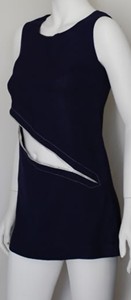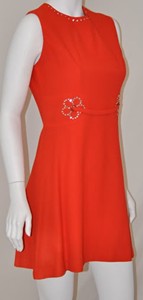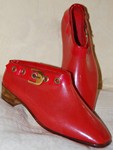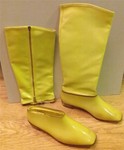Mary Quant

Mary Quant had an enormous influence on women's fashion in the 60s. Her designs pushed the boundaries of fashion and broke the dominance of the French couture houses. She became more than a fashion designer; she was one of the leaders of Swinging London. Although her designs influenced all women's fashion, they were expensive and only affordable to a minority of young women.
Mary Quant had a background in illustration which she studied at Goldsmith's College, London. Her first job in the fashion industry was designing and making hats for an upmarket milliner. She was dissatisfied with the amount of effort that went into making one bespoke hat which might only be worn once by a wealthy client. She thought that there had to be a better way.
Quant opened her first boutique, Bazaar, on the King's Road in Chelsea in 1955. The project was financed by her boyfriend and later husband, Alexander Plunkett-Green, and Archie McNair. Archie McNair had opened the first coffee bar, Fantasie (and one of the first in England) on the King's Road earlier in the same year.
Chelsea in the early 1950s was the Bohemian haunt of rich young men and women rebelling against the austerity measures of the Labour Government, or against their parents. Quant's new shop made Chelsea the centre of Swinging London. She appealed to the young, but to the young with money to spend. Her clothes were always expensive and never for the mass market. Whilst Chelsea had been a run down fashionably Bohemian district, the location for Quant's second Bazaar was very telling about the appeal of her clothes: she opened the new shop in Knightsbridge in 1961.
Quant found a gap in the market for affluent young women who did not want to dress the same way as their mothers. She found instant success, with some designs selling out on the day they were launched.

Initially Quant lowered the waistline. The high feminine waistline was a particular feature of 1950s fashion, led by Christian Dior's New Look. The original Chelsea girl look from the late 50s and early 60s was a tight black skirt, black stockings (tights were not invented then), long hair and high boots. This set the fashion trend from the early 60s. Quant was also influenced by what was going on in Carnaby Street and the beginning of the Mod movement. Later she herself was influenced by the Mods.
In 1961, in search of a wider audience for her clothes, Quant went wholesale, selling under the name 'The Ginger Group'. Ginger Group fashions were quite a bit cheaper than what Quant sold in her two Bazaars. However, they were still far from mass market fashion.
In March 1963 Quant exported to the USA creating a whole look: accessories, mix and match separates, coats, boots and stockings. Clothes sold from 5 to 10 guineas. Her Ginger Group collection sold for 10 to 39 guineas and her Bazaar collections for up to 50 guineas.
Quant's fashion became the standard by which other designers were judged. She invented 'the Look' in 1963 which was completed with a Vidal Sassoon bob hair cut. In that same year the Museum of Costume at Bath included a Modern Room in their display featuring clothes from 1960 to 1963. It included an outfit by Quant and a hat by Reed Crawford.

In 1965 Quant added a PVC rainwear collection to her range. As well as fashion, Quant sold a range of cosmetics which eventually became the most profitable part of her business. Quant has often been credited with inventing the mini skirt, but this accolade probably goes to French designer André Courréges. However, Quant' Bazaar was one of the first boutiques to sell mini skirts in 1965, although the hemline had risen above the knee before then.

Boots were very fashionable in the 60s; they complemented the look with mini skirts. Quant sold shoes and boots under the Afoot label. In 1967 she launched a range of boots with detachable tops (left). They could be worn either as boots or shoes, or possibly mixed and matched with different coloured tops if you bought two pairs.
By the end of the 60s Swinging London and Quant's 'look' was starting to appear conventional. Young people started to look to the East for influence, as well as delving into the past to source Victorian military uniforms in bright scarlet. By 1968 the maxi was beginning to edge out the mini for followers of the latest trends. However, the mini skirt continued well into the 70s in mainstream fashion.
At the end of the 60s Quant invented a staple of early 70s fashion, hotpants.
Resources for collectors
Photographs are invaluable in identifying the style and era of vintage fashion. For many more Quant clothes and accessories see Vintage Mary Quant gallery..
The majority of the images on this page and in our gallery were kindly provided by 60sPop.
By Steven Braggs, March 2013


Comments